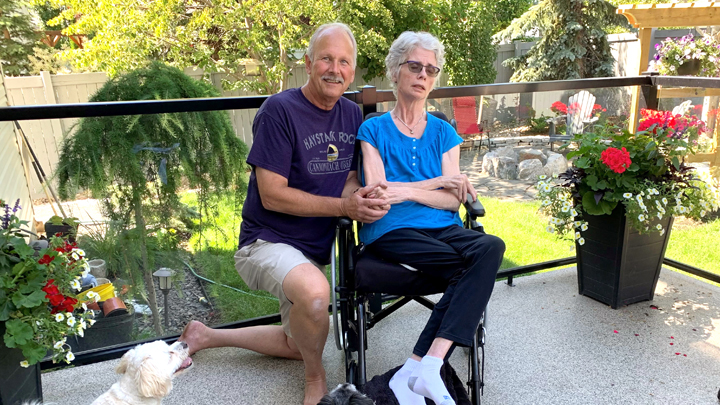
December 18, 2023

John and Nancy enjoy some sunshine on their 27th wedding anniversary in 2022.
Story by Kathleen Deman
Editor’s Note: This story of caring for and preventing pressure injuries is being told from the perspective of a husband caring for his wife.
EDMONTON — Nancy was diagnosed with dementia in late 2017, at only 56 years of age. For the first couple of years after her diagnosis, her husband John took care of her with no formal supports. As Nancy’s disease progressed, she required more support with her activities of daily living. This led John to pursue support through Alberta Health Services’ (AHS) self-managed care (SMC) program in 2020.
“When Nancy first started receiving home care support, she had health care aides helping her in the morning with getting dressed and bathing,” says John, Nancy’s husband, who asks their surname not be used, for privacy reasons. “Nancy was still somewhat mobile when SMC started, but she was requiring a lot of assistance.”
As Nancy’s condition worsened, she couldn’t reposition herself throughout the night due to lowered mobility. As her ability to communicate decreased, she couldn't indicate there was an issue, or when she was experiencing discomfort. Soon, a red spot started to form on her tailbone, which came and went for months.
An Occupational Therapist (OT) was consulted to assess for pressure-relieving devices and strategies. The OT suggested a wedge and pressure-relieving surface on Nancy’s bed, as well as a gel pad on her wheelchair. Even with these preventive measures, the redness eventually turned into a pressure injury.
The wound declined quickly once it opened. Nurses started to visit Nancy daily. Her care team put Nancy on oral antibiotics and arranged for a Vacuum-Assisted Wound Closure, or wound vac, which she used for four months.
With steady and diligent care, Nancy’s wound healed at home, without the need for hospitalization. Given the severity of Nancy’s pressure injury, the fact that it was able to heal completely and as quickly as it did with only minor medical intervention is immense, says John. Even today, the wound hasn’t re-opened.
To help Nancy prevent further pressure injuries, her OT suggested the use of a pressure-reduction mattress. Nancy has since stopped communicating verbally, so checking for pressure injuries is now part of her regular routine.
“One thing I’ve learned is how fragile skin really is — and how quickly things can decline,” adds John. “It’s so important to perform regular preventative skin checks, while keeping it as clean and dry as possible.”
John believes sharing his story can help prevent others from getting in a similar situation. The key is to educate patients, families and healthcare providers on how to recognize the early signs of pressure injuries and how to prevent them.
“Prior to Nancy’s wound, I was warned about pressure injuries but didn’t understand the impacts,” says John.
“This experience has opened my eyes to how important prevention is. Knowing the early signs of pressure injuries allows for the ability to have the right tools in place from the beginning.”
Learn more about preventing and caring for pressure injuries at MyHealth.Alberta.ca